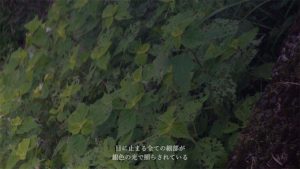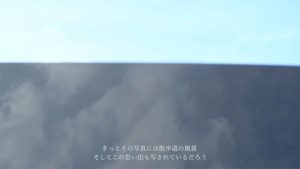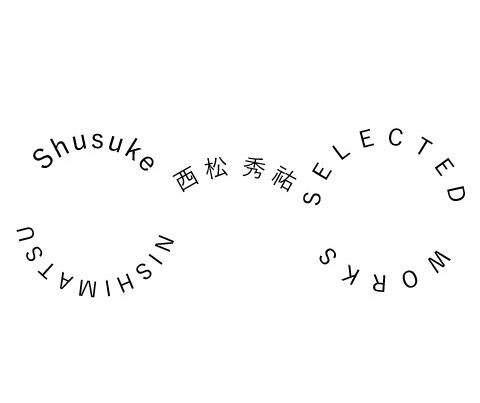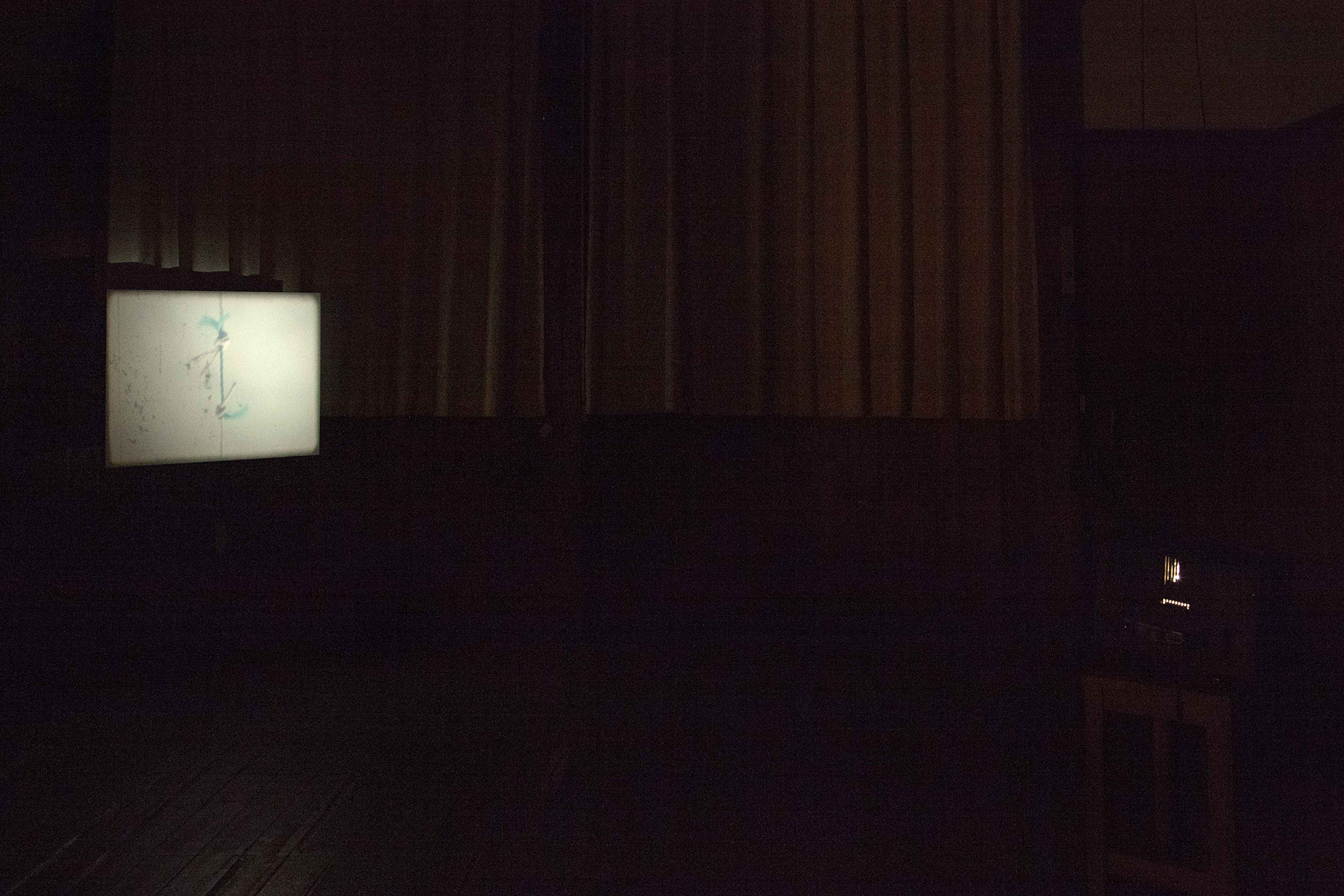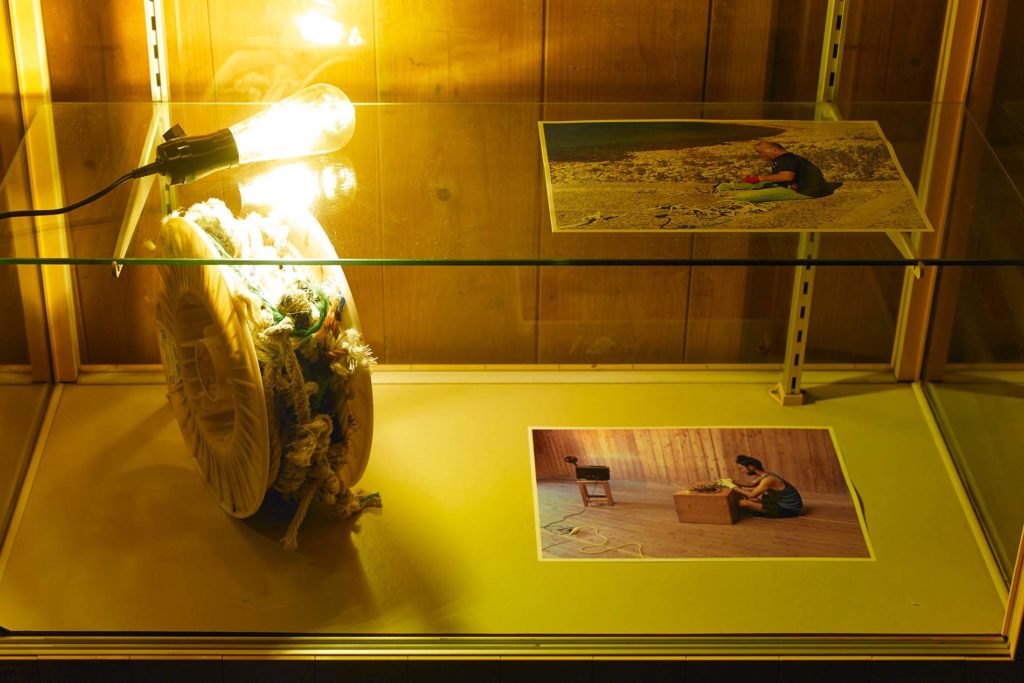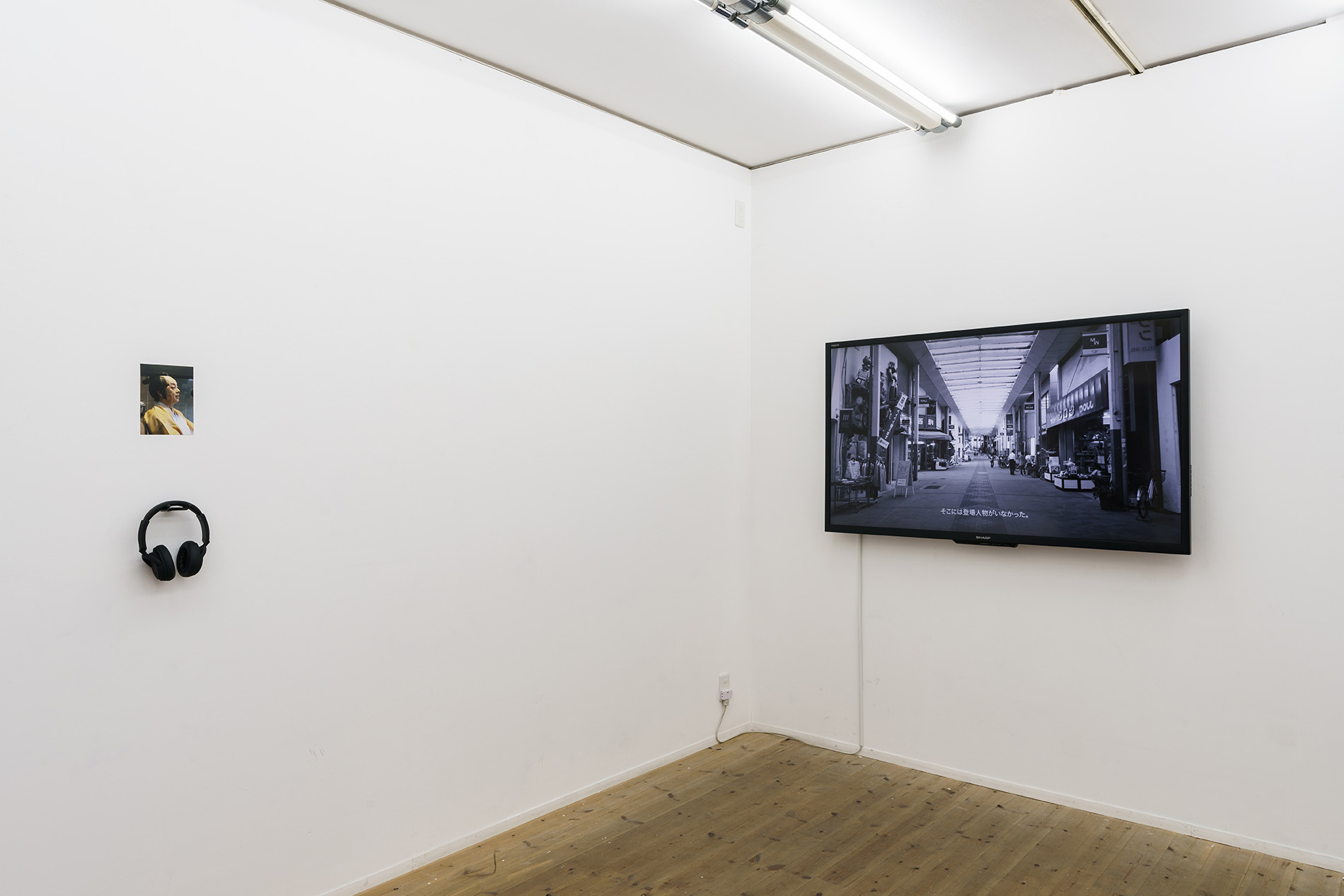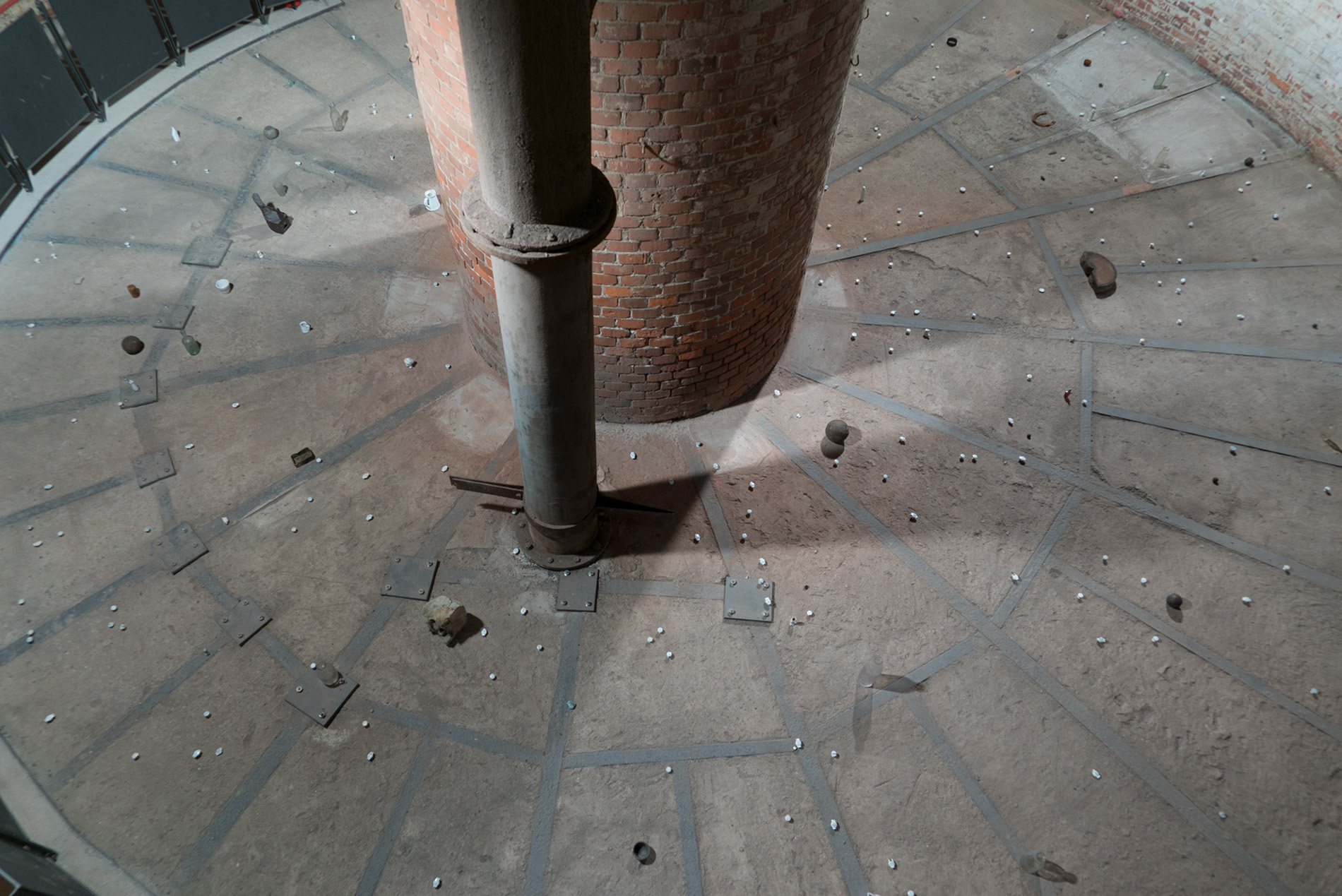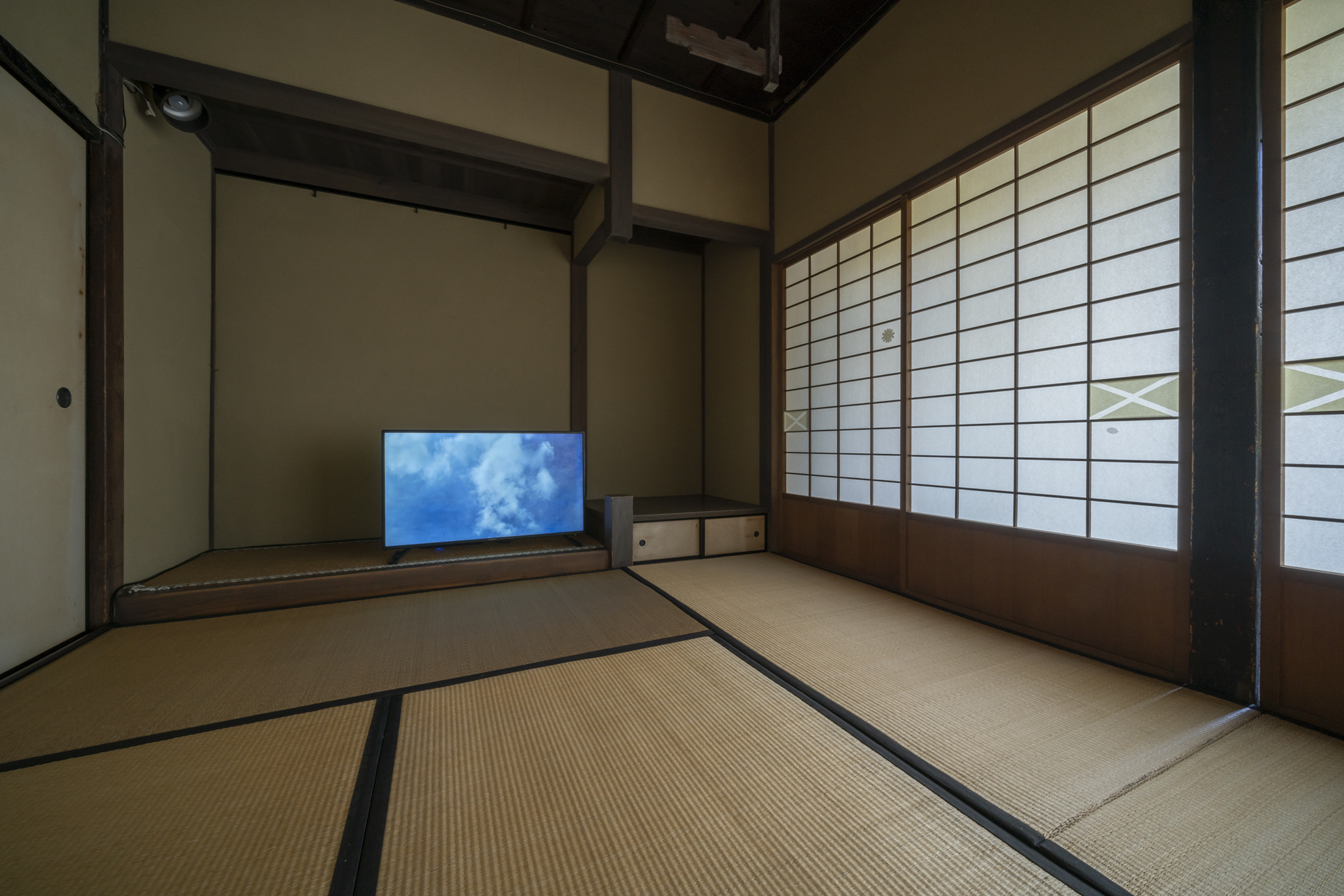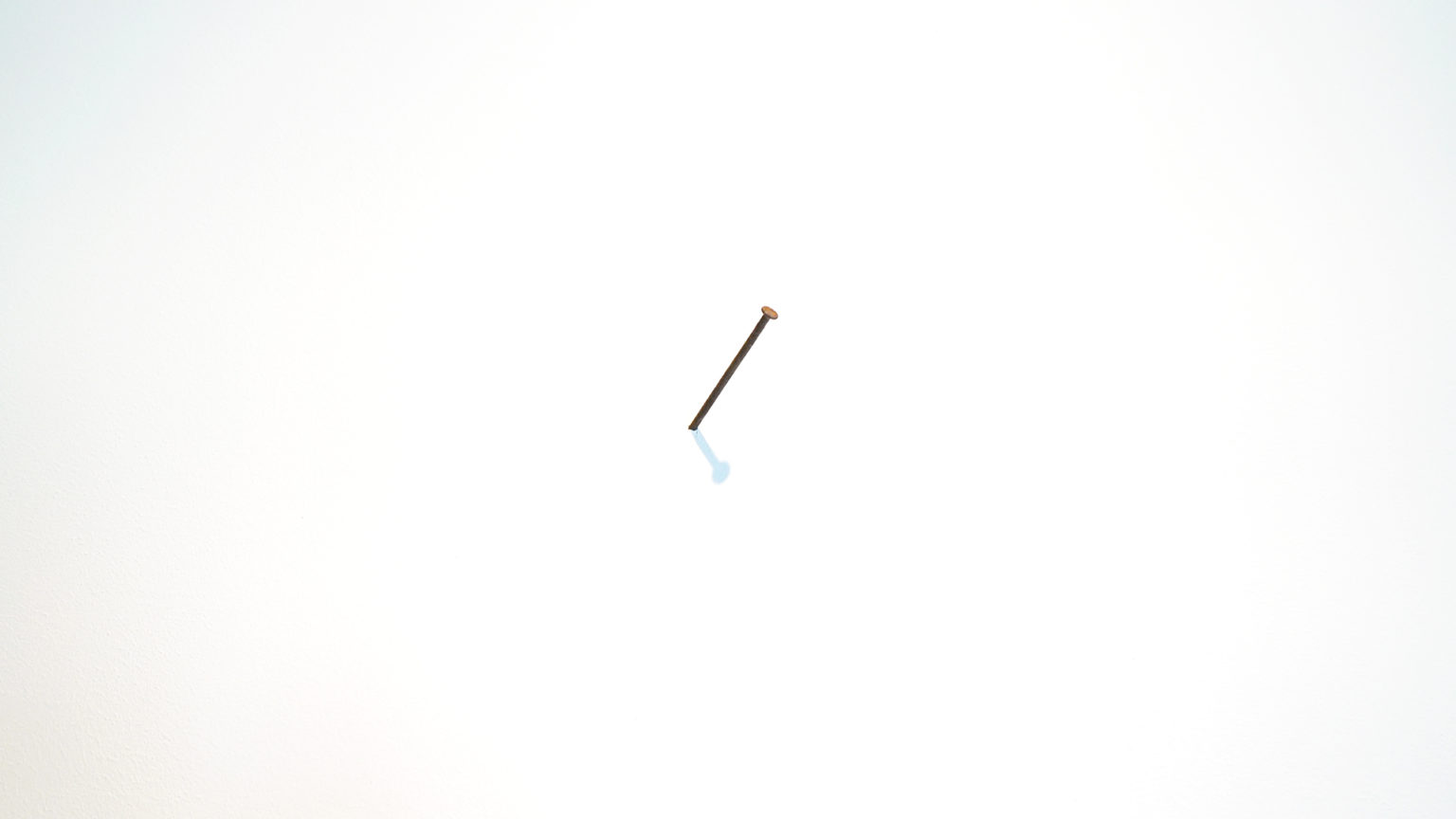
Last Minute Sculpture (when a work was installed)
2019 / Nail ( Found object in the exhibition space), Spotlight
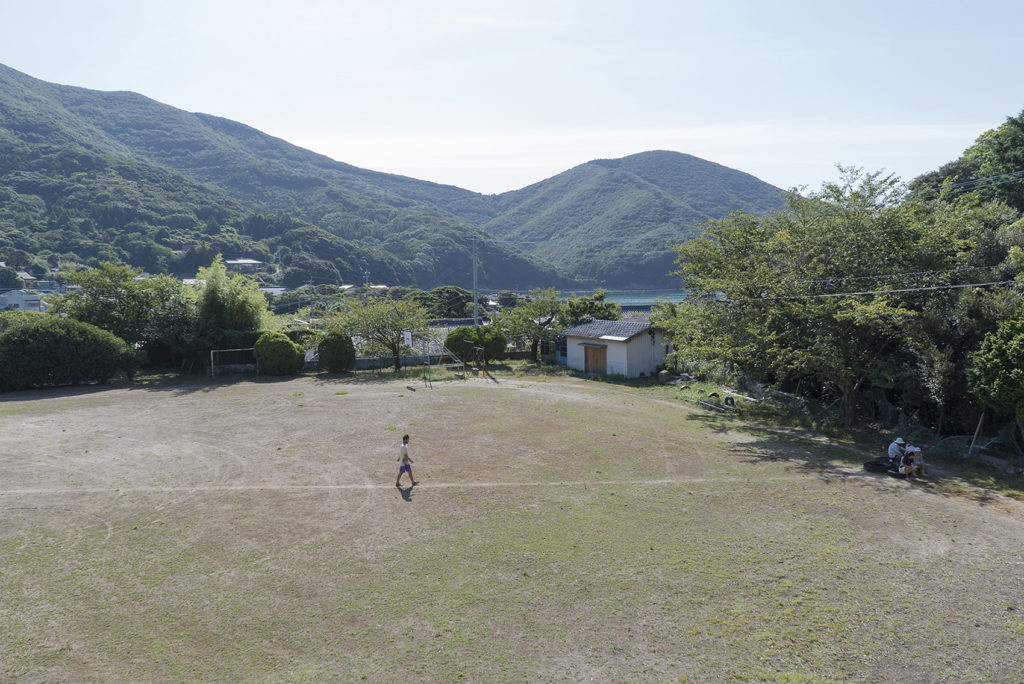
Intersection / 道のコミュニケーション
2015 / Photo documentation, Text
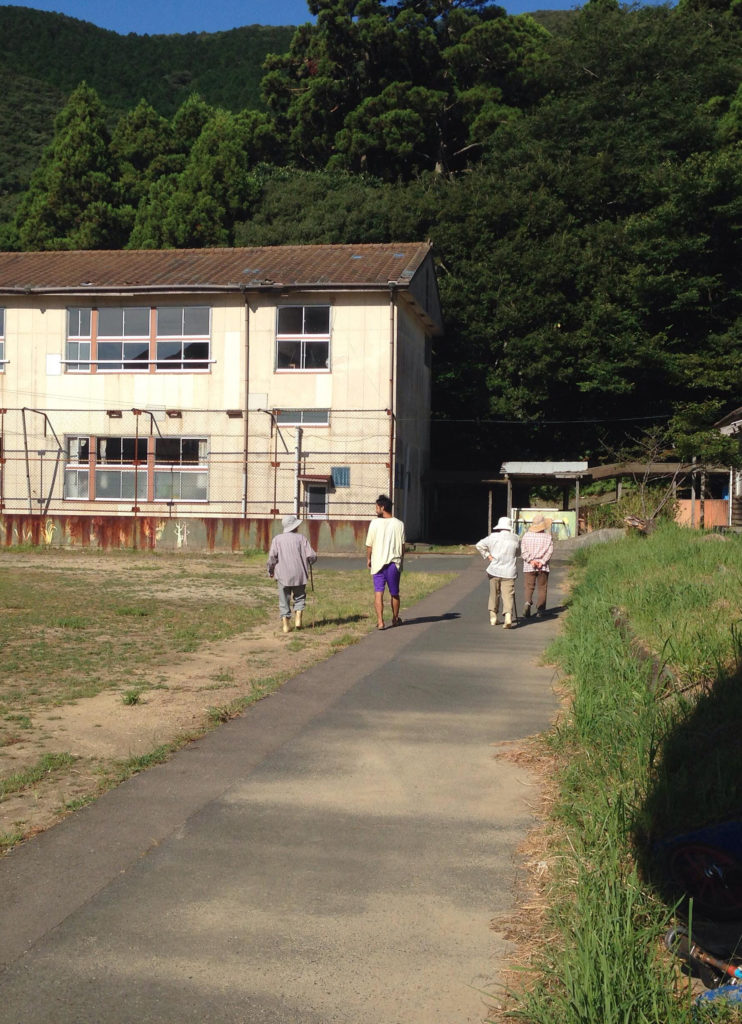
When I arrived at Naiin village in Tsushima islands for an exhibition, I use former primary school as an atelier.
In the beginning I didn’t know nothing about this village, and I felt little strange that I as an artist being here, where there is more old life style are kept. But slowly, through knowing villagers made me more comfortable.
I went to former primary school in an early morning, to start work for my project. Then 5 woman from the village came to walk in the school yard around half pass eight. And after their walk, they sat down and started to chat in the school field. I decided to join there chat. After that during my stay, I went to chat with 5 woman at school yard everyday. It was my daily rhythm, wake up, eat breakfast, chat with women, start work.
Some point when I was walking to them, I noticed there are trace where the women were walking. Talking with them on there trace, it made me think history of a road, probably every road I took in this village can also has some history of this villagers.
Few weeks later, After I continued to chat with 5 women everyday, I noticed a trace where I walked started to appear.Slowly increasing connection with people here.In one month the trace I made finally connected with the trace women made .When I saw this connection, I felt it could be the Intersection which art and village met.
対馬にある内院という集落に到着したばかりは、本当に右も左も知らない状態だった。昔ながらの生活が残っているこの内院という場所に、美術家として自分がここにいるという事に、なんとなく違和感があった。滞在中は廃校になった学校をアトリエとして制作をする。
でも内院に数年通っている先輩の方々から、街の人を紹介してもらい、徐々に街の子供達や大人たちと知り合いになっていくと、感じていた違和感みたいなものが徐々に溶けていくのを感じた。
ある時、朝早く学校に行き制作を始めると、街のお母さん5人ぐらいが校庭を散歩に来た。お母さん達は校庭を5周程回って、校庭にあるタイヤの回りに座って雑談をしていた。僕もお母さん達の雑談に混ぜてもらおうと、校庭を横切っていくと、お母さんたちが歩いた跡が道のようになっているのに気がづいた。その道の上でお母さん達と話していると、自分が今まで歩いていた内院の道も、そのお母さんたちが作った道のように、街の人の歴史が刻まれた道なんだと思った。
それから、毎朝お母さん達と話をしてから作業を開始する日々が始まった。ちょっと会話をして、仕事をする。なんとなく良いリズムだと思った。滞在開始から数週間も過ぎると、徐々にお母さんに会いに行く道みたいなものが、うっすら見え始めた。お母さん達が作った道につながる道。
僕が内院に来てから一ヶ月、芸術祭(対馬アートファンタジア)が内院の小学校を借りるようになって4年、徐々に繋がっていく人との関係、その道を眺めていると、お母さん達に会いに行く道が、美術と街が出会う道みたいにも見えるような気がした。
Fisherman’s Sequence / 漁師のシーケンス.
2018 / 8 mm film projection, sound, photos, roop, glass case / Duration: 6’30” min
Photo : Tadasu YAMAMOTO
In 2018 for an art festival at Tsushima island in Japan, I stayed in Naiin village for a month. Small village between mountains and the sea, most of the people who live there are working as fishermen.
On the ship to the Tsushima island, I saw a poster which showed how to tie lines with the fisherman’s technique. When I imagined a fisherman tying one to the other continuously, I felt it is similar to editing films which I usually do for my practice, connecting frame to frame to make a sequence and a storyline.
In Naiin I asked a fisherman to connect all the lines which I found on the shore while I interviewed him about his memory as a fisherman, his experience, life and history.
The line which was created through connecting multiple small lines during his talk about his memories can be understood as a fisherman’s sequence.
私は対馬にある内院と呼ばれる街に1か月ほど滞在した。その街は山と海に囲まれ、ほとんどの街の男たちは漁師、釣り舟の船長など海に関わる仕事をしていた。
たしかに対馬に向かう船の上、漁師の様々な紐の結び方が印刷されたポスターを見た。紐と紐を結んだり、紐で船と岸を結んだり、ブイを結んだりする、漁師のロープワーク。漁師の方が紐と紐を結ぶ、その姿を想像したら、なんかアナログフィルムの編集をしている人のように思えた。私は作品作りで映像を使うことがある。カメラで撮ったものをコンピューター上で切ったり貼ったりして、一つの映像を作る。
滞在中、僕は漁師の方にたくさんの紐を持って、どんな海の冒険をしてるのだろうか、お話を聞きに行った。語られながら結ばれていく一本の紐、それはきっと漁師の映像なんだろうと思う。最終的にその結ばれた紐を8ミリフィルムで撮影し、漁師の方のお話とともに展示した。
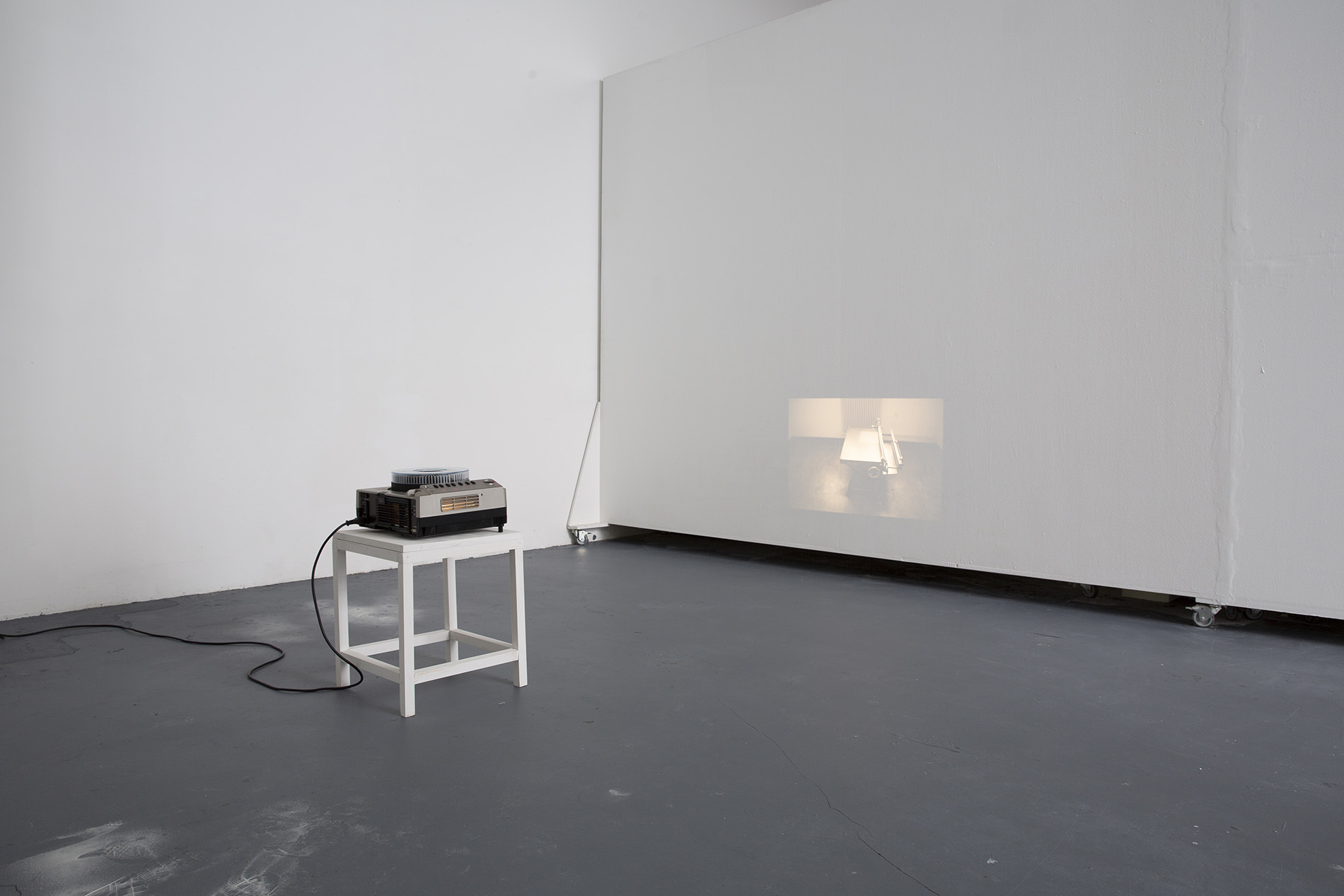
When shutter close / シャッターが閉じた時
2017 / 81 Slide, 35 mm, projection projector
A light from a window is shining on a paper-cutting machine. The moment, the light is cut off. It resembles the structure of a photograph. Taking a picture of the scene, compose the shot, and press the shutter. A sound of a camera shutter echos like a sound of a cutting machine.
紙を切る裁断機の上に、窓から光が差し込んでいる。光が切り取られた瞬間。それは写真の構造に似ている。構図を決めシャッターを押し、カメラでその光景を撮影する。シャッター音が裁断機の音の様に聞こえてきた。
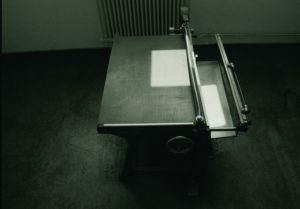
Two Episodes / 二つのエピソード
2019 / HD-Video, Sound, E-mail HD-Video, Stereo, Bluetooth Headphone, Photo / Duration : 7’01″min
Photo : Satoshi MORI
When the film was first imported into Japan, there were performers called Benshi who provide live narration for silent films. The first benshi, Ueda Hoteiken, he was also a Chindon-ya. It’s a Japanese marching bands for advertise a shops and other establishments on the street.
In the black-and-white video that slowly passes through the shopping street shows narrateon by Mr. Kitahara, who owns coffee shop and runs Chindon-ya group there, and also in the subtitles it tells the history of a shopping street, towns and films.
日本に映画が輸入された当初、活動弁士と呼ばれる、サイレント映画にライブでセリフをいれる人たちがいた。その初代活動弁士、上田布袋軒はもともとチンドン屋さんだった。
商店街の中をゆっくり抜けていくモノクロの映像には喫茶店経営、チンドン屋をしている北原氏のナレーションが語られる。そして街の歴史、商店街の歴史そして映画史論が混ざったテキスト字幕が綴られる。
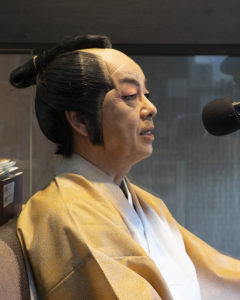
Fluss als Zeitlinie (Rivier as Timeline) / 川のタイムライン
2017 / 8 channel sound installation, Collection from Rainer Borgunski ( found object from river Elbe ) 81 slide, 35mm slide carousel projection, Text , Map
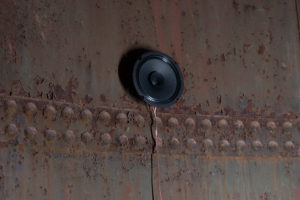
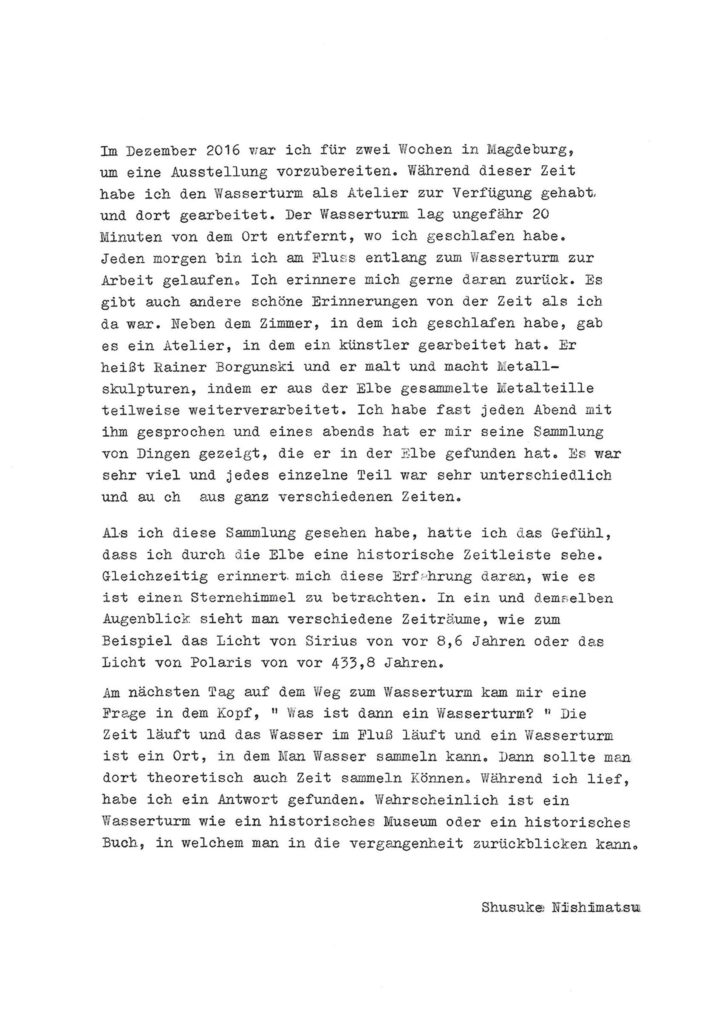
(Translation)
December 2016 I stayed in Magdeburg for about two weeks to prepare for the exhibition. During my stay I used the pumping room of the former water tower as an atelier. It was about a 20 minute walk from where I stayed, and every day I walked along the river Elbe to the water tower.
In my memories of Magdeburg, the most impressive one was meeting Borgunski. He had an atelier next to my room where I slept, he does painting and iron sculpting with found object which he collects from the river Elbe.
One night he saw me the collection he found on the river Elbe. A completely different kind, and different ages. It was a lot of collections, beer bottles, some ancient objects, cannon ball, and jewelries, etc. Looking at the collections late at night made me feel as if I was looking at the history of the land through the river Elbe. The experience of seeing things from completely different times under a small lamp in the dark room. The seeing various time zone at the same time was little bit like a seeing stars at night. The light of Polaris was 433,8 years ago, and Sirius was 8,6 years ago, etc, The next day I was walking along the river Elbe as usual towards the water tower. One question caught me.
“If time flows like a river, what is a water tower then?”Time goes by. the water of the river flows. the water tower stores the water of the river.As I walked along the river Elbe, I felt like I somehow found the answer.“I think the water tower should be a place where time can be stored then. Archiving space, where people can look back on the past, like a museum.
2016 年の12 月私は2 週間ほど展覧会の準備のためマグデブルグに滞在した。滞在期間中、私は貯水塔のポンプ室をアトリエと使用していた。そこは滞在場所から徒歩20分ほどの距離にあり、私は毎日エルベ川沿いの道を歩いて、貯水塔に通った。今思うとたくさんの思い出があるけれど、特に印象的だったのが、ライナー ボグンスキーに会った事だろう。彼は私の寝泊まりしている部屋の横にアトリエを構えて制作していて、絵を描いたり、エルベ川で拾った鉄を使った彫刻を作ったりしていた。
ある夜、彼はエルベ川で見つけた収集物を私に見してくれた。全く違った種類のもの、違った時代のもの、本当にたくさんの収集物だった。その収集物達を夜遅く眺めていると、まるでエルベ川を通して、その土地の歴史を見ているような、そんな気分になった。暗闇の中ランプの下で全く違った時代のものを同時にみる体験が、どこか夜星を眺めているような気分にさせた。ポラリスの光が433,8 年前、シリウスが8,6 年前、様々な時間軸を同時に見る感覚。
翌日私はいつものようにエルベ川沿いを歩きながら貯水塔へ向かっていると、一つの疑問が頭に浮かんだ。
『もし時間が川のように流れるなら、貯水塔って何なんだろう?』時間が流れ、川の水も流れる。そして貯水塔には川の水が溜まっていく。時間が川のように流れ、川の水が溜まっていく。
エルベ川沿いを歩きながら、私は何となく答えを見つけたような気がした。きっと貯水塔は時間も溜まる場所なんだろう。そしてそこは時間がアーカイブできる博物館や一冊の歴史の本のように、昔のことを振り返る事ができる場所なんだろう。
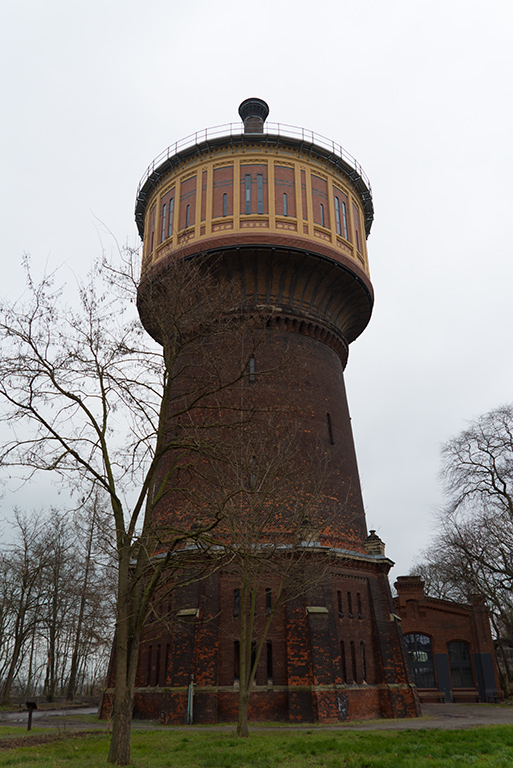
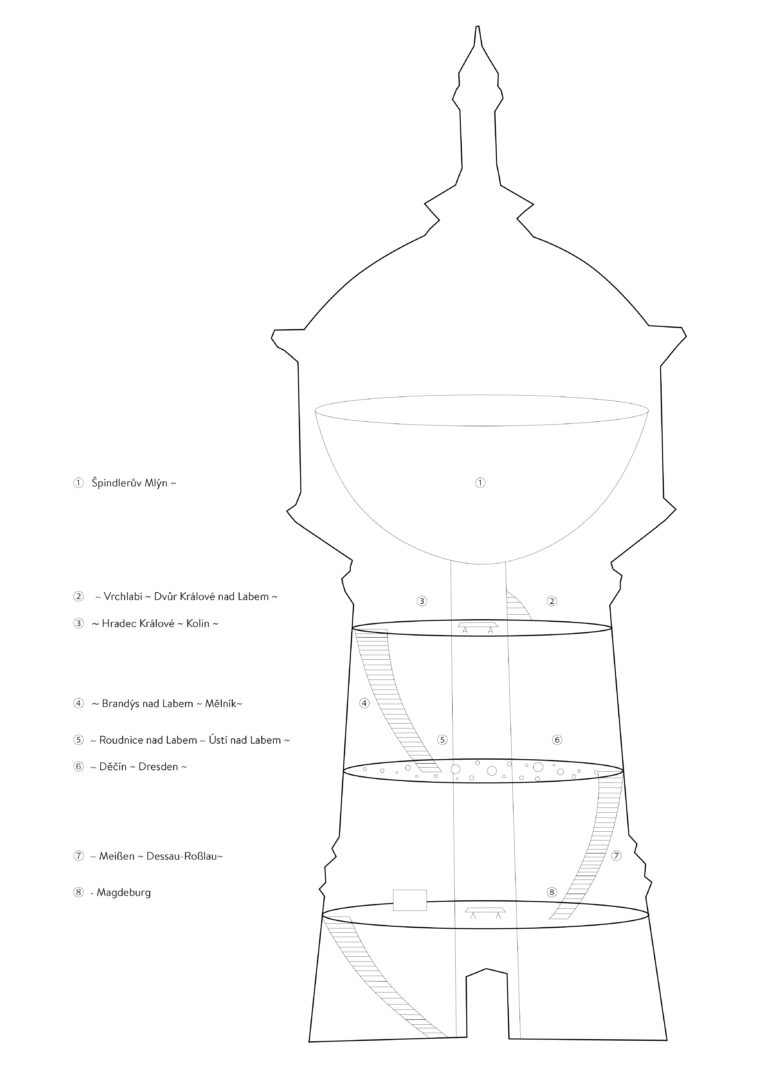
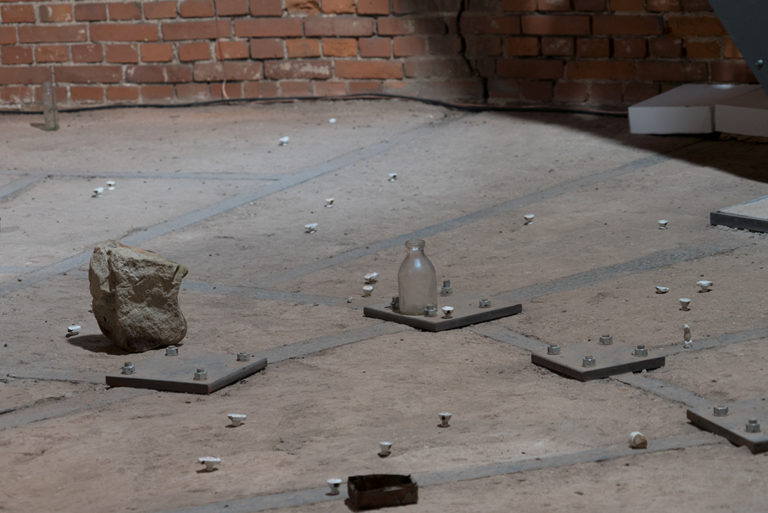
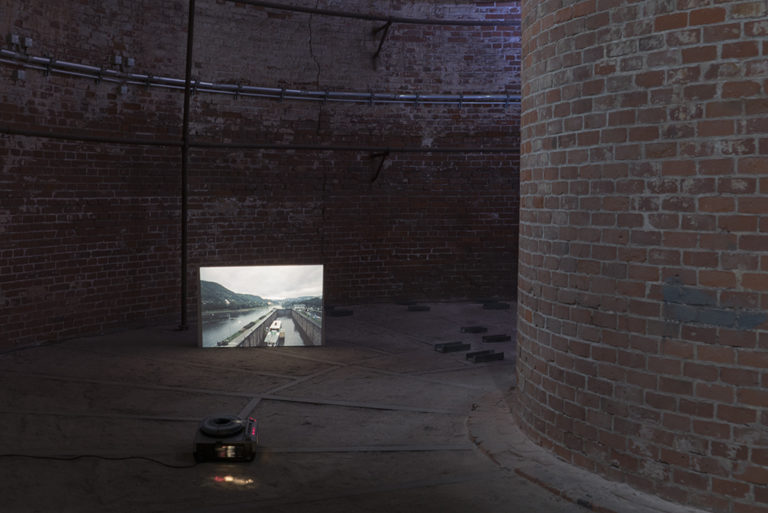
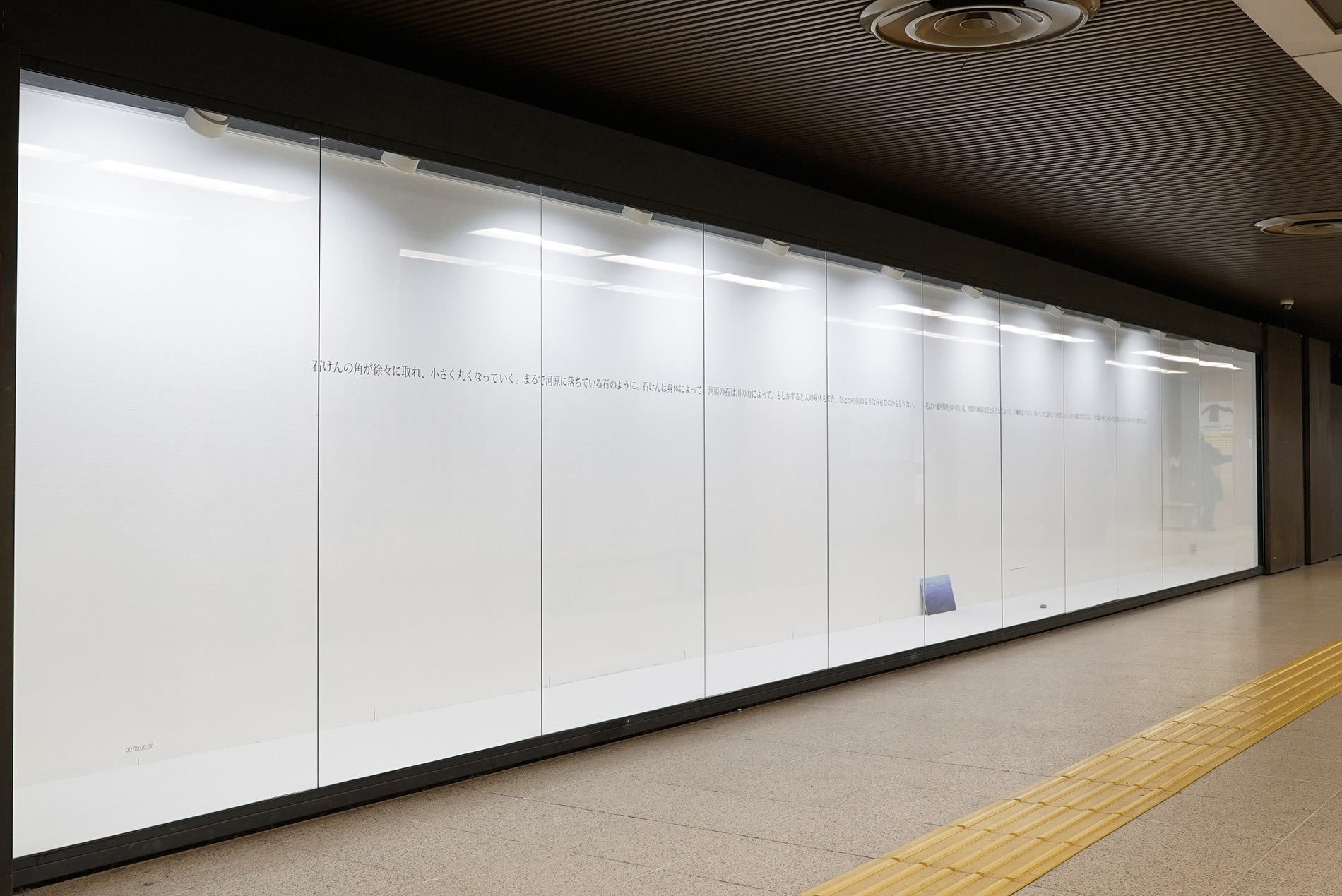
Body as Timeline / 身体のタイムライン
2020 / Text, Video Stills, Stone, Soap
An art museum in an underground passage. Seeing an art work while walking, it can includes the actual walking distance and time. I don’t know of any other museum which these elements ( time and distance ) must be aware of.
The first motivation for this work began with a small discovery, that the way soap gets smaller and smaller, was similar to the stones of the river. From that little discovery, I often went to the river to find a stone that looked similar to my soap. The exploration took several days, and I began to think about the body, the river, and the time.
In this work, which contain several media, still image taken from a video of a river flowing, a text about a river and body, soap and stone, and actual stone and soap. It is an experimental video work which can play by reading through walking.
地下通路の中に存在する美術館。そこで作品を歩きながら見るという鑑賞方法には、実際に歩く距離や時間というものが含まれる。(時間と距離)そういったことが意識しやすい美術館を私は他に知らない。
この作品制作の初めの動機は、徐々に小さく丸くなっていく石鹸が河原の石とよく似ているなと思ったことから始まった。その小さな発見から、私はその石鹸によく似た石を探すため河原によく通いました。その探索作業は何日にも渡り、自然と私は河原で、身体と川そして時間の流れについて考えるようになったと思います。
少し専門的な話になりますが、映像編集ではタイムラインというものがあり、そこに編集されたカットを一本の時間軸上に並べ、映像を再生します。川が流れている映像からとった静止画像、川と身体、石鹸と石についてのテキスト、そして石と石鹸からなるこの作品は、歩くことで再生される、映像が投影されない実験的な映像作品だと思います。
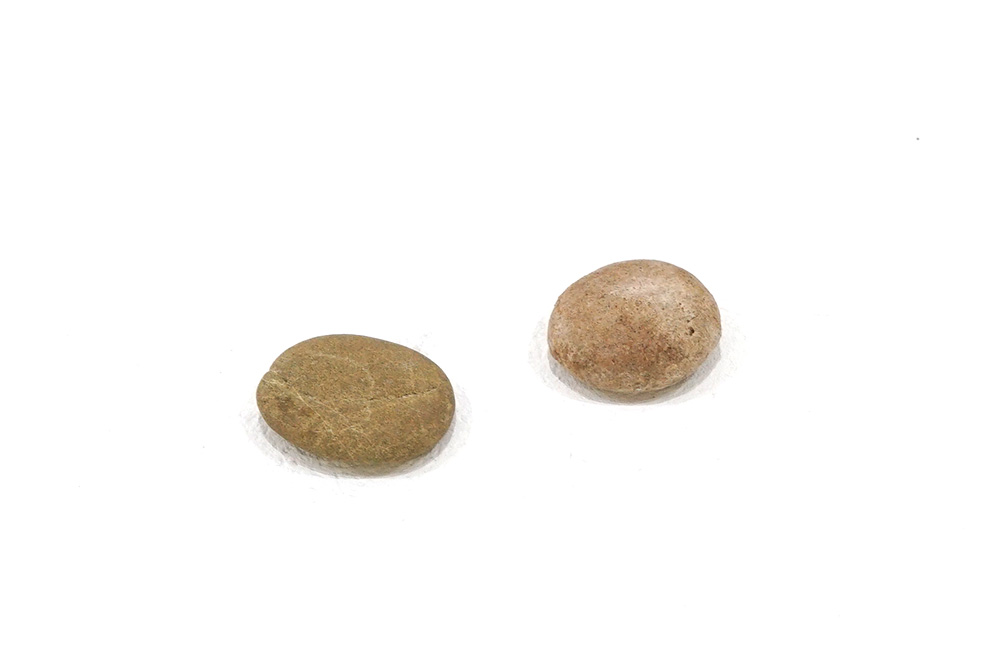
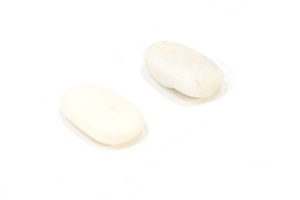
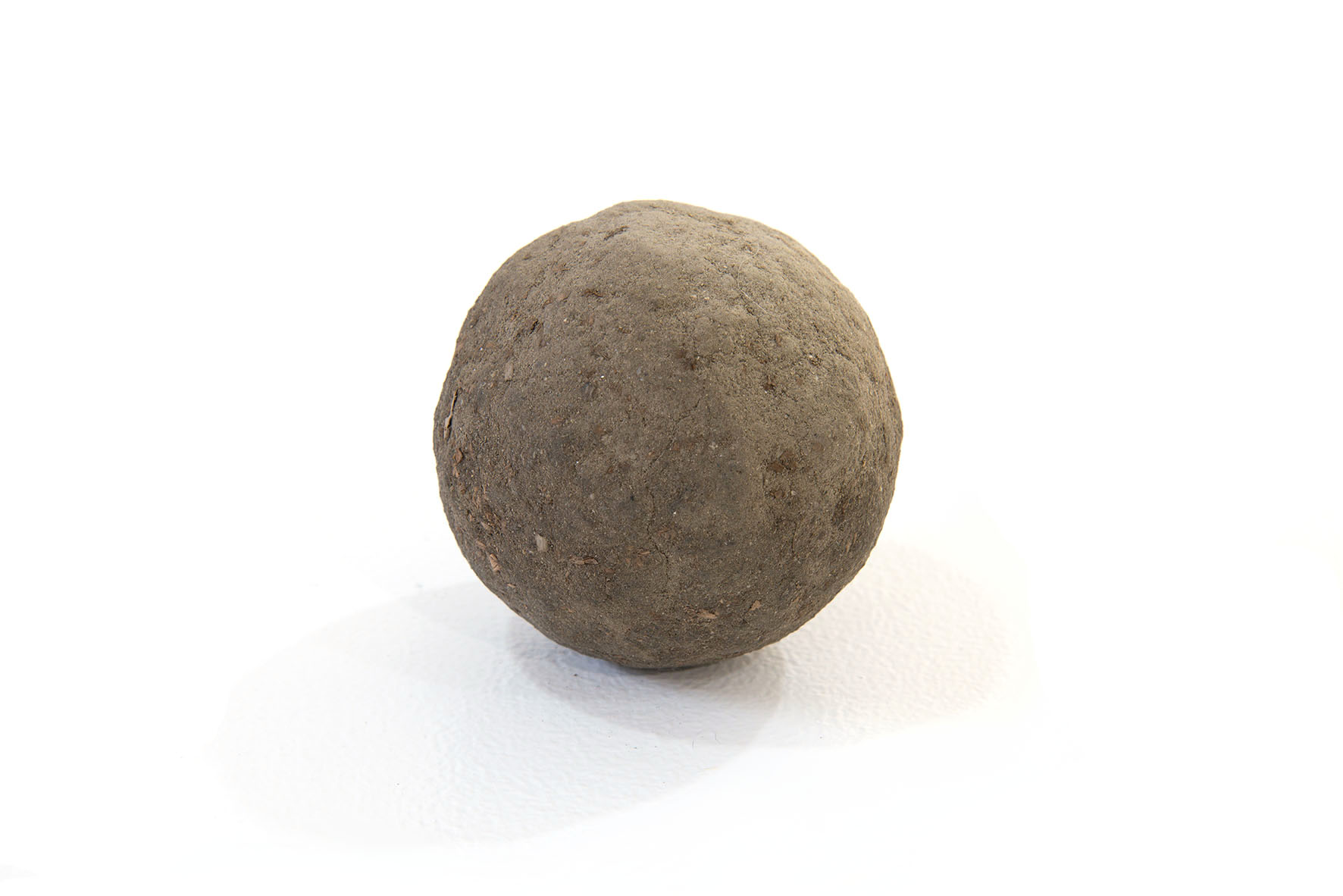
Small planet in the supermarket / スーパーマーケットの小さな惑星
2015 / Soil (collected from supermarket vegetables) Text / Φ 6cm
I made this work in Tokoname, Aichi in 2015. While I was cleaning potatoes bought at the supermarket, the dirt on my hands made me think as if I had been playing in soil and gave me a feeling of nostalgia. The potatoes were from Hokkaido, a place of which I had never experienced the touch of its soil. The work is a planet of both nostalgia and strangeness, made based on this experience.
ある時夕食でカレーを作るために、僕はスーパーマーケットでジャガイモやにんじんなどを買った。家に着くとさっそくカレーを作り始めた。まず僕は水道水でじゃがいもを洗った。洗っていると僕の手には土がつき少し茶色くなっていた。その手はまるで土遊びをした手みたいだった。
僕はふとじゃがいもの袋を見た、そのじゃがいもは北海道産だった。僕は今まで土遊びを北海道でした事がないし、それに北海道の土を手で触った事がないように思えた。もう一度その手を眺めてみると何だかとても不思議な気がした。
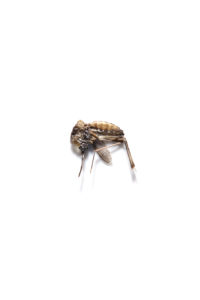
Stranger
2012 / Mosquito, Text
Going somewhere with an airplane. I usually go too early, I have to wait at waiting room after the duty-free area. I often read a book, listening music or think something while I am waiting, Waiting something or having a time, is good moment to think. For example “Waiting room at Airport” , Being here means going somewhere. The Waiting room, no choice for going back and staying. The place contains here and there. Those thing I often think there.
At that time, I was at transit somewhere southern airport, As usual, I had some time left. I was sitting on a chair at the waiting room.
Then a mosquito came on my arm. I snapped my arm with reflect, and I caught it. A mosquito that lived at waiting room, the place of here and there. I looked around the waiting room. There were many people of various races. This mosquito must be a creature that has lived with the blood of various races.
If the earth with this globalism still exist in the future around few decades century away, probably the blood which this mosquito mixed can be the same. I think this mosquito is an apt symbol of the hyper global existence.
Yet, if I considered another perspective, I was remembering the time when SARS, international disease occurred, many people with white uniform were trying to kill all the mosquito which exist in airport. Because it can become a dangerous vehicle for transmitting disease from human to human.
The creature that kills humankind most is human beings. But the next creature is mosquitoes.
I thought this mosquito is probably the most modern creature that lived in the most modern places. I gently put it between pages of the book I was reading to preserve its important presence.
飛行機に乗って、どこかへ行く。まずチェックインカウンターへ行き、ボーディングパスをもらい、スーツケースを預ける。そして手荷物検査を受け、免税店エリアを抜けて飛行機に乗る。だいたい早く行きすぎるので、免税店をぬけた所にある待合室の椅子に座って飛行機を待つ事になる。時間を持て余したりしていると、色んなことを考えたりする。私はよく椅子に座りながら『ここはどこなんだろう?』とか考えながら過ごしたりしている。ここにいるという事はどこかへ行かなくてはいけない場所、よっぽどの事がない限り、さっき済ませた手荷物検査の向こうには戻れない。そうするとここはここでなくどこかなのかぁ。とかそんな事をぼーっと考える。
その時は飛行機を乗り継いでの移動で、どこか南の方の経由地点の飛行場だったと思う。いつもの様に少し時間を持て余していた。私は待合室の椅子に座っていた。
すると一匹の蚊が私の腕にとまった。無意識にパチンと腕を叩き、私はその蚊を捕まえた。ここではなくどこかとして存在する場所に生息していた一匹の蚊。そうやって私の周りを見渡すと、そこには本当に様々な人種の人がいた。この蚊はきっと多様な人種の血を吸ってきた生き物なのだろう。
もし数十世紀先にも私たちが知っている世界が存在していたら存在する血の混ざり方が、この蚊にはあったのかもしれない。 超グローバルな存在としての一匹の生物。そんな風に思ったりさえした。
でも少し冷静になって考えてみると、この蚊はとても危険な生物なのかもしれないと思った。私は子供の頃にみたSARSが流行った時の事を思い出していた。大人たちが空港に存在する蚊を、滅殺する映像。国際病が発生した時に、ウイルスを伝染する媒介になる危険な存在。たしか人類をもっとも殺した生物は、人だ。でもその次に多い生物が蚊だ。
この蚊はきっともっとも現代的な場所に生息していたもっとも現代的な生き物だと思った。私はその重要な存在を保存するため、読みかけの本の1ページの間にそっとはさんだ。
A Story of Photography / 写真見聞記
2020 / 4K-Video, Stereo Sound, Single channel / Duration :4’58” min
Photo: Takashi KUBO
